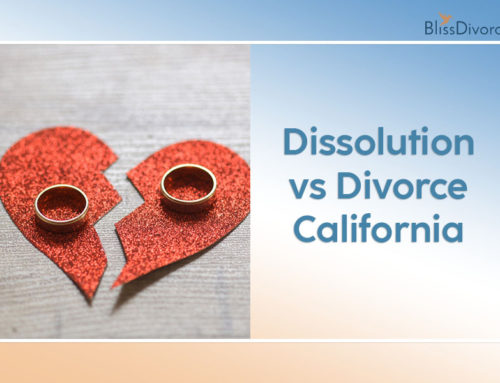Divorce has become out of reach for some in recent years due to the rising cost associated with the process. A big part of the problem is that divorce lawyers in California and other states charge high fees that leave both parties with further debt. Instead of reaching an amicable end to the relationship, they get stuck in a process that can drag on for years and cost tens of thousands of dollars.
Instead, couples can file their uncontested divorce with the aid of an online divorce service. Your split can be peaceful, inexpensive, and completed in less than six months if you fulfill the criteria and follow the straightforward procedure.

Source: shutterstock.com / Photo Contributor: kenary820
Online Divorce – What Is It?
Divorcing online is just what it sounds like — completing the divorce process online, without having to go to court or meet with an attorney. There are two ways to do this.
First, you can prepare the documents yourself. Many states, including California divorce, have electronic, fillable PDF versions of documents you can prepare yourself. There are online instructions to help with this, and states like California provide family law self help centers to assist you. California and other states permit “e-filing,” allowing couples to submit their completed court documents online.
But be forewarned, divorce papers are legal documents. They are complicated and not easy to understand. Trying to do it yourself often leads to paperwork being rejected by the courts. Then the process has to start over and this can be very frustrating.
The alternative is to use an online divorce service to go through the divorce process. These online services will provide information and assistance in completing the forms, and in some cases help you structure your divorce agreement and even work out disputes.
The Online Process for a Divorce
Before starting the online process for a divorce, check if your state and court accept filing for a divorce online. Also, you must ensure you and your spouse fulfill the state rules and regulations to be eligible for a divorce.
Not every state has the exact requirements. Some have different waiting periods, residency rules, or common ground for an at-fault divorce in some states.
Petition for divorce
In most states, you will need to start the divorce process by getting a petition for divorce, also known as a “petition for dissolution.” The petition for divorce contains some basic questions about your marriage that you will need to answer before submitting it. Also, state what court orders you seek for alimony or property division issues.
If you are a California resident, you will find all the necessary forms on the state’s official website. The site also has a petition for dissolution. For online divorces, spouses pay the filing fee with a credit or a debit card.
Service of process
For the divorce process to move forward, you must deliver copies of the dissolution petition to your spouse. This is what the service of process is. Most states need you to complete the service process within a given timeframe. In California, you must serve the service papers at least 16 days before your court date, if you’ve requested one.
After serving the papers, your spouse has a legal timeframe to respond. If your spouse does not respond, the divorce process can proceed without them.

Source: shutterstock.com / Photo Contributor: Andrii Yalanskyi
Important decisions
The next step is for you and your spouse to agree on important decisions. If your spouse does not respond to the service of process in California, you can make the decisions yourself. If the other party responds, you must agree on property distribution, child custody, debts, and alimony.
You can use mediation for a decision where you cannot agree. Mediation is a low-cost option to help you reach an uncontested divorce. Mediation is useful if you and your spouse have disagreements on any issue but believe you can resolve it with some help.
- Property distribution – Community Property states use the 50/50 split guideline when it comes to property division. But, most states practice the Equitable Distribution principle in which property is divided fairly but not necessarily 50/50.
- Child custody – The determining factor in child custody in almost all US states is what is best for the child. Most courts split child custody 50/50 or with one parent having primary custody while the other can set visitation rights.
- Alimony – Alimony is available in all states temporarily, short-term, or long-term. Temporary alimony lasts during the divorce proceedings. Short-term alimony lasts a set period following the divorce. Long-term alimony is permanent, and rarely do the courts award it.
Finalize the divorce
You or the online service helping you must submit the final forms to finalize your divorce. The court and the judge presiding over your case will then analyze the forms to ensure that there are no mistakes or missing documents.
If everything is in order with the paperwork, the judge will sign the judgment and state the date your marriage officially ends. But, if you are a California resident, the state requires a waiting period of six months from the date divorce papers are served on the responding spouse. Your divorce will not be official until that date..

Source: shutterstock.com / Photo Contributor: Roman Motizov
What If You Can’t Reach An Agreement?
One of the downsides of online divorce is that you don’t have attorneys or mediators to help you work out an agreement that will be accepted by the court.
But there is an alternative. One online divorce solution, BlissDivorce, includes Digital Divorce Mediation to help you work out an agreement. These highly effective tools can be used over your computer, without even interacting with your spouse. They identify what’s important to you, what’s important to your spouse, and then offer compromises that both spouses will usually accept. If any items are not resolved through Digital Divorce Mediation, BlissDivorce offers Zoom-based mediation to work out the final issues.
So now you can use online divorce to not only prepare your paperwork, but also to work out a complete divorce agreement without attorneys involved. That saves you a lot of time and money.
BlissDivorce is currently only available for California divorces. But they have plans to expand into other states soon.
Advantages of Divorcing Online
The big advantage of online divorce is that it saves a huge amount of money.
The average national cost of divorce when attorneys are involved is currently upwards of $25,000! Online services range from $250 to $5,000, much cheaper than a traditional divorce. Or you can do it yourself for next to nothing, although it is usually hard to figure out the confusing legal requirements of divorce in California and other states.
Online divorce platforms are helpful because they guide you through the process. They can assist you in filling out state-specific legal forms for a set charge. Some online divorce services even offer a satisfaction guarantee. They are usually worth the extra cost and are much less expensive than attorneys or mediators.
But remember that online platforms cannot offer you legal advice. They can provide information to help you make your own decisions. But if you need legal advice you will need to consult with a lawyer.
The following advantages of using an online service for your divorce:
- Provide you with a step-by-step guide on the divorce process
- Thanks to the inexpensive flat fee, you do not have to pay attorney expenses
- Help with form completion to avoid making expensive mistakes
- Access to mediation tools and/or divorce mediators
- Drawing up your divorce agreement
- Filing divorce paperwork on your behalf

Source: shutterstock.com / Photo Contributor: rangizzz
Conclusion
Online divorce is an excellent solution for couples who want to avoid the incredibly high costs of attorneys and are willing to try to work out their differences. While most online divorce services just help you document an agreement you’ve already reached, there are now some services that will help you work out your differences. So as long as you’re willing to try to work things out over the Internet without lawyers involved, you can do a full divorce online.
Divorce is stressful, and ending a relationship is never easy, so make the process easier by trying to reach an agreement fair for both parties. Online divorce services are an excellent solution for a peaceful end to a marriage.




